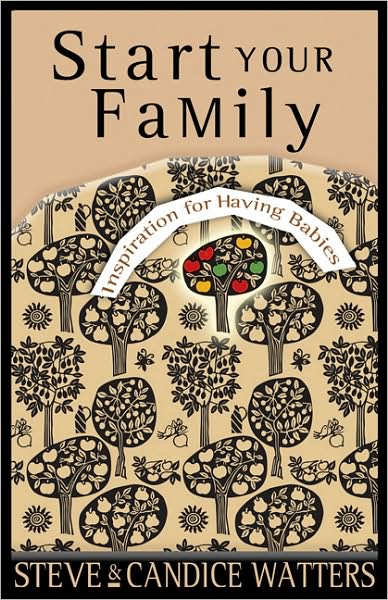God's Design for Marriage: "Be Fruitful and Multiply"

Created Male and Female
Our culture is obsessed with body image. The ability our bodies have to attract and engage someone sexually has been elevated far above the miracle inherent in the sex act. Body parts that can experience great pleasure during sexual intercourse are also specifically designed to produce, incubate, and nurture new life. Because reproduction changes a woman’s body image and her availability for sexual intercourse, however, it is often seen as a lesser good. As a result, we have a cultural wedge between body image and body use—between form and function.
It wasn’t like this in the beginning. Having a child wasn’t seen as a threat to the perfect body. It was rightly understood to be the natural and desired fruitfulness for which our bodies were made. “Haven’t you read,” Jesus asked the Pharisees when they questioned Him about the issue of divorce, “that at the beginning the Creator ‘made them male and female,’ and said, ‘For this reason a man will leave his father and mother and be united to his wife, and the two will become one flesh’?” (Matthew 19:4-5). Jesus’ use of the term one flesh resonated with those scholars who knew their Old Testament justifications for divorce. They would recognize the phrase from Genesis, but also from Malachi’s answer to the question, “And why one [flesh]?” “Because he was seeking godly offspring” (Malachi 2:15, italics added).
“Form and function should be one,” architect Frank Lloyd Wright once said, “joined in a spiritual union.”9 The form and function of our bodies were joined in a spiritual union at the beginning. Our purpose in producing families is “imprinted on our nature as human beings” writes family historian Dr. Allan Carlson, and it “can be grasped by all persons who open their minds to the evidence of their senses and their hearts to the promptings of their best instincts.”10
“My body and its consequent desires provided self-evident testimony to my purpose,” says author Gary Thomas. “As a man, I could look at my body and discern that I was designed to be a husband and a father.” Gary said he didn’t need to seek a burning bush or God’s perfect will about whether or not to have children. “God had already made His will clear. For me, the call to have children was similar to being a soldier who is ordered to ‘go take that hill.’”11
God told Adam and Eve to “be fruitful” and built fruitfulness into their bodies, but He also reinforced the design of fruitfulness by creating earth as a verdant planet. “Ask the animals, and they will teach you, or the birds of the air, and they will tell you; or speak to the earth, and it will teach you, or let the fish of the sea inform you” (Job 12:7-8). The earthy elements of our bodies testify to that same purpose. We have the same awe-inspiring ability to be fruitful. “Blessed are all who fear the Lord, who walk in his ways,” says Psalms 128. ”You will eat the fruit of your labor; blessings and prosperity will be yours. Your wife will be like a fruitful vine within your house; your sons will be like olive shoots around your table” (Psalms 128:1-3).
A woman’s period is a monthly reminder of her potential fruitfulness—as her body releases one or two of the 450 mature eggs she has available between puberty and menopause. And during each act of intercourse, a husband’s virility is represented in the release of somewhere between 40 million and 1.2 billion sperm cells.12
If just one of those millions penetrates the egg, nature’s most amazing form of fertilization begins—initiating complex DNA connections between egg and sperm, weaving together all the details for a new life. Here’s how Louie Giglio explained it to a group of young people in a message called “How Great Is Our God”:
"One cell from your mom met up with one cell from your dad—each one carrying twenty-three chromosomes. The one from your mom was carrying half of her DNA, the one from your dad was carrying half of his DNA, and those two cells met and merged into one single cell. And when they did those chromosomes matched and they began to form together a brand-new DNA code.
"Using four characters—four nucleotides—they began to write out what we have now discovered is the three billion–character description of who you are, written in the language of God . . . They described who God ordained you to be.
"And when they formed together they wrote out and painted a picture which had never been written before in the history of humankind. And then that cell did the unthinkable. It set out to build [you] from one cell.13
We are indeed “fearfully and wonderfully made” (Psalms 139:14). What makes it all even more amazing is what separates us from all the rest of God’s creation. While He superintends the complexities of fruitfulness throughout nature He actively participates in the miracle of human reproduction by adding a soul and ordaining the days for each new boy and girl (see Psalms 139:13-16).
Ordained for Procreation
Even though men and women have the potential to produce this miracle in their marriage, less than a third of couples see having children as the purpose of marriage. A survey by Pew Research implies that the great majority of Americans believe marriage is primarily intended for a couple’s “mutual happiness.”14 We were raised in Christian families and attended Christian colleges, but we still went into marriage thinking primarily about the mutual happiness that we hoped to find in our companionship, sexual intimacy, and financial partnership.
The visit from the Morkens we mentioned [in an earlier chapter] motivated us to be intentional about starting our family, but the transition from being partners to parents was still quite a change to our vision of marriage. As incredible as it was to bring our first baby into the world, the whole process—beginning with the first signs of morning sickness—felt like a major renovation of the marriage we had already built.
What we came to realize is that the “house of love” we had custom designed for our marriage wasn’t as “kid-ready” as we assumed it was. (The “Mission” chapter on the other end of this book looks in more detail at the effect of children on a marriage. The context for marriage in this chapter is the tension between the unions we design for ourselves and the design God established in the beginning).
That tension grows stronger as our culture of personalization and individualism inspires couples to mold marriage in their own image. While today’s couples often seek to put their unique stamp on marriage and bring their own meaning to the union, generations before us were more likely to adapt to what marriage expected of them. We were reminded of just how much that expectation included children while watching the A&E version of Pride and Prejudice. In the closing scene, as Mr. Darcy and Elizabeth and Mr. Bingley and Jane exchange vows in a joint wedding ceremony, the priest reads from the Anglican Book of Common Prayer:
"DEARLY beloved, we are gathered here in the sight of God, and in the face of this congregation, to join together this Man and this Woman (and this man and this woman) in holy Matrimony; which is an honourable estate, instituted of God in the time of man’s innocency, signifying unto us the mystical union that is between Christ and his Church; . . . duly considering the causes for which Matrimony was ordained.
"First, It was ordained for the procreation of children. Secondly, It was ordained for a remedy against sin, and to avoid fornication; Thirdly, It was ordained for the mutual society, help, and comfort, that the one ought to have of the other, both in prosperity and adversity. Into which holy estate these two persons present come now to be joined (emphasis added).15
While many married couples today hope to have children at some point, few grasp the idea that their marriage was “ordained for the procreation of children.” One definition of ordain is “to prearrange unalterably or predestine.”16 That sense of inherent purpose has characterized marriage almost universally for most of world history. In fact, the word matrimony emerged from the Latin word matrimonium that literally meant “state of motherhood” based on the association of marriage with parenthood.17
Whether they knew it or not, our ancestors tapped into a primary purpose of their marriage by contributing to our genealogy. For many of them, this was not a purpose they discovered at the end of an arduous quest for meaning. “For most of the nation’s history, Americans expected to devote much of their life and work to the rearing of children,” writes sociologist Barbara Dafoe Whitehead. “Life with children was central to marriage and family life, to norms of adulthood, and to an adult sense of purpose.”18
“We were all created to do as our parents have done, to beget and rear children,” said Martin Luther. “This is a duty which God has lain upon us, commanded and implanted in us, as is provided by our bodily members, our daily emotions and the example of all mankind.”19
One way God “implanted in us” a design for children was by reflecting His communal nature in the structure of the family. Consider the description of the Trinity in the Westminster Confession of 1647:
"In the unity of the Godhead there be three Persons of one substance, power, and eternity: God the Father, God the Son, and God the Holy Ghost. The Father is of none, neither begotten nor proceeding; the Son is eternally begotten of the Father; the Holy Ghost eternally proceeding from the Father and the Son."20
In Focus on the Family’s The Truth Project, Del Tackett shows how God designed the family to reflect His image:
"The Holy Spirit proceeds from the Father and the Son. Children proceed from the husband and wife. What an incredible picture of the triune God stamped upon His first social institution and it’s not going to be a surprise to us that the world, the flesh and the devil that hates the nature of God, hates this structure as well."21
Disdain for this original design is obvious in the world surrounding us. Dr. Al Mohler, president of The Southern Baptist Theological Seminary, says that the sexual revolution not only liberated sex from marriage, “but also from procreation.”22 Author Gary Thomas says it this way: “One of our spiritual enemy’s purposes for the sexual revolution was to motivate us to have as much sex as we can outside of marriage and as little as we can within marriage, and worse, for us to have as many babies as we can outside of marriage and as few as we can within it.”23
God intended for your marriage to be different. It was His purpose for you to enjoy all the benefits of mutual love, but He also designed you so that your love could spill over fruitfully into a family, a family that reflects His very nature of communal love. Dr. Mohler believes that understanding God’s purpose for family is a significant aspect of our purpose in life:
"Our chief end is to glorify God—and marriage is a means of His greater glory. As sinners, we are all too concerned with our own pleasures, our own fulfillments, our own priorities, our own conception of marriage as a domestic arrangement. The ultimate purpose of marriage is the greater glory of God—and God is most glorified when His gifts are rightly celebrated and received, and His covenants are rightly honored and pledged."24
Elsewhere, Dr. Mohler elaborates on those gifts:
"Marriage represents a perfect network of divine gifts, including sexual pleasure, emotional bonding, mutual support, procreation, and parenthood. We are not to sever these 'goods' of marriage and choose only those we may desire for ourselves. Every marriage must be open to the gift of children."25
Instead of seeing children as a threat to the other blessings of marriage, we can embrace the fact that God created all the good things of marriage to work in harmony. Dr. Mohler encourages Christian married couples to “reject the contraceptive mentality that sees pregnancy and children as impositions to be avoided rather than as gifts to be received, loved and nurtured.”26
Not even the most creative couples among us can improve on God’s design for fruitful marriages. We can trust that His purposes for marriage are good and can satisfy our desires better than any alternatives our culture offers. “The estate of marriage and everything that goes with it in the way of conduct, works, and suffering is pleasing to God,” Martin Luther wrote. “Now tell me, how can the heart have greater good, joy, and delight than in God, when one is certain that his estate, conduct, and work is pleasing to God?”27
Originally published April 28, 2009.

Steve and Candice Watters founded Boundless.org webzine for Focus on the Family in 1998. Candice served as the Boundless editor for four years until leaving in 2002 to be a freelance writer and editor. She is the author of Get Married: What Women Can Do to Help It Happen. Steve is director of young adults for Focus on the Family. He is the author of Real Solutions for Overcoming Internet Addictions. The Watters met at Regent University where they earned their master's degrees in Public Policy. They have four children.
Photo credit: ©GettyImages/SrdjanPav
Originally published July 16, 2011.







